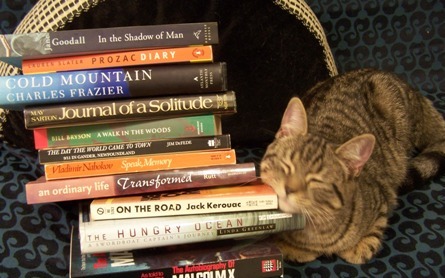I have not visited any Willa Cather historical sites and would like to very much. I have a signed copy of one of her books, published in 1940. What a great name for a mid-western Nebraska town! Red Cloud.
2. Emily Dickinson Museum in Amherst, MA.
I have visited the Dickinson home and everything about that trip was wondrous. I definitely want to go again. What I recall most vividly is the preservation of Emily's white dress, and the little pocket she had sewn on the side. As she went about the house doing chores, she would stash snatches of poetry. I also learned that she was an avid baker. She would bake things for her nephews and niece and lower the goodies down from her bedroom window in a basket.
3. Edith Wharton House in Lenox, MA
Wow, pretty opulent. Edith Wharton was clearly upper middle class. I would like to visit her house. Also that area of Massachusetts is gorgeous.
4. Bronte Parsonage, Haworth, England
I went to see the Bronte Parsonage this past summer, during my archeological trip to England. I wrote about the parsonage in an earlier post (October 14, 2013). It was wonderful and a long awaited dream fulfilled!
5. Edgar Allan Poe Museum, Richmond Virginia.
I have not been here; in fact I have never been to Virginia. This would be a nice place to visit with Jonathan.
6. Edward Gorey House, Yarmouthport, Cape Cod, Massachusetts
Despite the fact that Edward Gorey's house is so close, Jonathan and I just recently visited in October of 2013. It was a great treat and there was so much to see I'd like to visit again.
7. Henry Miller House, Big Sur, California
I am interested in the scenery as much as I am interested in seeing the museum. Hopefully I'll get to visit some day. It would be cool to see some rare first editions and photographs.
8. Jane Austen's House, Hampshire, England
Oh yes, it would be great to visit Jane Austen's house. She is so popular these days, though, I bet it would be a mob scene. I love it when authors of yesteryear maintain their popularity!
9. Anne Frank House, Amsterdam, Holland
I visited the Anne Frank House when I was in Holland in 1999. I really enjoyed the experience, and I remember there was a long line! Well worth the wait. I recall I was most impressed by the copies of all the translations of Anne Frank's diary in a glass display, in almost every language! Also, I remember that in the neighborhood that Anne lived- which was predominantly Jewish- eighty percent of the inhabitants perished by the end of the war. It is amazing that her father Otto survived at all. He was the only survivor in his family. Seems like divine providence.
10. Louisa May Alcott House, Concord, Massachusetts
Shame on me. I've never been to the Louisa May Alcott house, and it's located 7 miles from my house! I've got to plan a trip this summer. It's time to play tourist in my own town!

button.jpg)
wine.jpg)
nail.jpg)
coin.jpg)

glass.jpg)













![Woman's Life in Colonial Days [Paperback] [1999] (Author) Carl Holliday](http://ecx.images-amazon.com/images/I/51p4-SGTViL._SL110_.jpg)

































